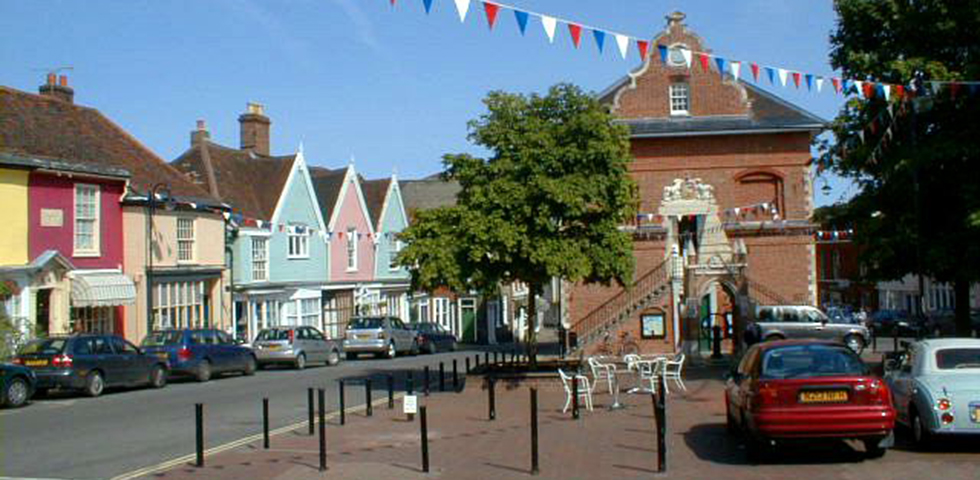The Town of Woodbridge, Suffolk

We are a well positioned bed and breakfast to be able to explore the lovely streets and boutiques of Woodbridge. The town lies along the River Deben, with a population of about 7,480. It is served Woodbridge railway station on the Ipswich-Lowestoft East Suffolk Line. Woodbridge is twinned with Mussidan in France. Woodbridge is close to the most important Anglo-Saxon site in the United Kingdom, the Sutton Hoo burial ship. With 1400 years of recorded history, the town has retained a variety of historical architecture, and there are facilities for boating and riverside walks on the River Deben.
Archaeological finds in the area show habitation from the Neolithic Age (2500-1700 B.C.).
The area was under Roman occupation for 300 years following Queen Boadicca’s failed rebellion in 59 A.D. but there is little evidence of the Romans’ presence. When the Roman soldiers were recalled to Rome in 410 A.D., there was a substantial Anglo-Saxon (Germanic) settlement. It was the Angles who gave East Anglia its name.
In the early 7th century King Rædwald of East Anglia was Bretwalda, the most powerful king in England. He died in around 624, and he is probably the king buried at Sutton Hoo, just across the river Deben from Woodbridge. The burial ship is 89 feet long, and when its treasures were discovered in 1939 they were the richest ever found in British soil. They are kept in the British Museum in London. Replicas of some items, and the story of the finds, are to be found in the Woodbridge Museum, and the National Trust has built a Visitor Centre on the site.
The earliest record of Woodbridge dates from the mid-10th century, when it was acquired St Aethelwold, bishop of Winchester, who made it a part of the endowment of the monastery he helped to refound at Ely, Cambridgeshire in AD 970.[citation needed] The Domesday Book of 1086 describes Woodbridge as part of the Loes Hundred. Much of Woodbridge was granted to the powerful Bigod family, who built the famous castle at Framlingham.
The town has been a centre for boat-building, rope-making and sail-making since the Middle Ages. Edward III and Sir Francis Drake had fighting ships built in Woodbridge[citation needed]. The town suffered in the plague of 1349, but recovered enough, and with encouragement from the Canons, and growing general prosperity, to have a new church (now St. Mary’s, behind the buildings on the south side of Market Hill)) constructed with limestone from the Wash and decorated with Thetford flint. By the mid 15th century the Brews family had added a tower and porch.
On 12 October 1534, Prior Henry Bassingbourne confirmed Henry VIII’s supremacy over the Church and rejected the incumbent “Roman Bishop”. Nonetheless, Woodbridge Priory was dissolved three years later.[3] As religious unrest continued in the reign of the Roman Catholic Mary Tudor, Alexander Gooch, a weaver of Woodbridge, and Alice Driver of Grundisburgh were burnt for heresy on Rushmere Heath. Alice previously had her ears cut off for likening queen Mary to Jezebel. The subsequent religious settlement under Elizabeth I helped Woodbridge industries such as weaving, sail-cloth manufacture, rope-making and salt making to prosper, along with the wool trade. The port was enlarged, and shipbuilding and timber trade became very lucrative, so that a customs house was established in 1589.
Around the town there are various buildings from the Tudor, Georgian, Regency and Victorian eras. Woodbridge has a tide mill in working order, one of only two in the UK and among the earliest. The mill first recorded on the site in 1170 was run the Augustinian canons. In 1536 it passed to King Henry VIII. In 1564, Queen Elizabeth I granted the mill and the priory to Thomas Seckford. In 1577 he founded Woodbridge School and the Seckford Almshouses, for the poor of Woodbridge. Two windmills survive, Buttrum’s Mill, and Tricker’s Mill. The former is open to the public.
